Agronomic Performance and Fruit Quality of Fresh Fig Varieties Trained in Espaliers Under a High Planting Density
Abstract
1. Introduction
2. Materials and Methods
2.1. Plant Material
2.2. Evaluation of Agronomic Parameters
2.2.1. Yield, Ripening Period, and Cumulative Yield
2.2.2. Trunk Cross-Section Area and Yield Efficiency
2.3. Evaluation of Quality Parameters
2.3.1. Fruit Weight and Width
2.3.2. Firmness
2.3.3. Colour Measurement
2.3.4. Total Soluble Solids
2.3.5. Titratable Acidity, pH and Maturation Index
2.3.6. Statistical Analysis
3. Results and Discussion
3.1. Agronomic Parameters
3.1.1. Yield and Ripening Period
3.1.2. Cumulative Yield, Trunk Cross-Section Area, and Yield Efficiency
3.2. Quality Parameters
3.2.1. Weight, Width, and Firmness
3.2.2. Colour
3.2.3. Total Soluble Solids, Titratable Acidity, pH, and Maturation Index
4. Conclusions
Author Contributions
Funding
Data Availability Statement
Conflicts of Interest
References
- Watson, L.; Dallwitz, M. The Families of Flowering Plants: Descriptions, Illustrations, Identification, and Information Retrieval. 1992. Available online: https://www.scirp.org/reference/referencespapers?referenceid=2844233 (accessed on 3 May 2025).
- Yang, Q.; Liu, Y.; Guo, Y.; Jiang, Y.; Wen, L.; Yang, B. New Insights of Fig (Ficus carica L.) as a Potential Function Food. Trends Food Sci. Technol. 2023, 140, 104146. [Google Scholar] [CrossRef]
- FAOSTAT. Available online: https://www.fao.org/faostat/es/#home (accessed on 3 May 2025).
- Superficies y Producciones Anuales de Cultivos. Available online: https://www.mapa.gob.es/es/estadistica/temas/estadisticas-agrarias/agricultura/superficies-producciones-anuales-cultivos/ (accessed on 3 May 2025).
- López-Corrales, M.; Pérez, F.; Manuel, G.; Serradilla, M.J.; Pereira, C. Estructura Varietal Del Cultivo Del Cultivo de La Higuera En Extremadura. In La Agricultura y la Ganadería Extremeñas en 2021; Coleto, J.M., Muslera, E., Pulido, F., Eds.; Caja Badajoz: Badajoz, Spain, 2012; pp. 121–130. [Google Scholar]
- Galván, A.I.; Serradilla, M.J.; Córdoba, M.G.; Domínguez, G.; Galán, A.J.; López-Corrales, M. Implementation of Super High-Density Systems and Suspended Harvesting Meshes for Dried Fig Production: Effects on Agronomic Behaviour and Fruit Quality. Sci. Hortic. 2021, 281, 109918. [Google Scholar] [CrossRef]
- Galán, A.J.; Martín, A.; Torres-Vila, L.M.; Ruiz-Moyano, S.; Galván, A.I.; Serradilla, M.J.; López-Corrales, M. Quantification and Identification of Damage Caused by Pests and Fungi in Dried Figs from Orchards with Different Levels of Agronomic Management in the Main Production Areas of Extremadura (SW Spain). Crop. Prot. 2023, 172, 106334. [Google Scholar] [CrossRef]
- Pereira, C.; Serradilla, M.J.; Martín, A.; Villalobos, M.d.C.; Pérez-Gragera, F.; López-Corrales, M. Agronomic Behaviour and Quality of Six Fig Cultivars for Fresh Consumption. Sci. Hortic. 2015, 185, 121–128. [Google Scholar] [CrossRef]
- Batlles-delaFuente, A.; Belmonte-Ureña, L.J.; Duque-Acevedo, M.; Camacho-Ferre, F. A Profitable Alternative for the Spanish Southeast: The Case of Production of Figs in Greenhouses. Agronomy 2022, 12, 2577. [Google Scholar] [CrossRef]
- Jafari, M.; López-Corrales, M.; Galán, A.J.; Galván, A.I.; Hosomi, A.; Nogata, H.; Ikegami, H.; Balas, F.; Serradilla, M.J.; Garza-Alonso, C.A.; et al. Orchard Establishment and Management. In The fig: Botany, Production and Uses; Sarkhosh, A., Yavari, A., Ferguson, L., Eds.; CABI: Wallingford, UK, 2022; pp. 184–230. [Google Scholar]
- Maia De Sousa, R.M. Fig Culture Techniques. Acta Hortic. 2003, 605, 99–101. [Google Scholar] [CrossRef]
- Urbina Vallejo, V. Mòdul 10. Monografías de Fruticultura—N.o 11. Poda y Formación de Los Frutales; Urbina Vallejo, V., Ed.; Escuela Técnica Superior de Ingeniería Agraria, Universidad de Lleida: LLeida, Spain, 2017; ISBN 978-84-697-7927-9. [Google Scholar]
- Musacchi, S.; Iglesias, I.; Neri, D. Training Systems and Sustainable Orchard Management for European Pear (Pyrus communis L.) in the Mediterranean Area: A Review. Agronomy 2021, 11, 1765. [Google Scholar] [CrossRef]
- Ibell, P.T.; Normand, F.; Wright, C.L.; Mahmud, K.; Bally, I.S.E. The Effects of Planting Density, Training System and Cultivar on Vegetative Growth and Fruit Production in Young Mango (Mangifera indica L.) Trees. Horticulturae 2024, 10, 937. [Google Scholar] [CrossRef]
- Mahmud, K.P.; Ibell, P.T.; Wright, C.L.; Monks, D.; Bally, I. High-Density Espalier Trained Mangoes Make Better Use of Light. Agronomy 2023, 13, 2557. [Google Scholar] [CrossRef]
- Iglesias, I. Costes de Producción, Sistemas de Formación y Mecanización En Frutales, Con Especial Referencia al Melocotonero. Rev. Frutic. 2019, 69, 50–59. [Google Scholar]
- Iglesias, I. Sistemas de Plantación En Frutales Adaptados a La Mecanización, Eficiencia y Efectos En Los Costes de Producción. In Proceedings of the 7° Congreso Internacional de Frutos Rojos, Huelva, Spain, 22–23 June 2022. [Google Scholar]
- Schöneberg, T.; English, L.A.; Popp, J.; Hamby, K.A. Impact of Modified Caneberry Trellis Systems on Microclimate and Habitat Suitability for Drosophila suzukii (Diptera: Drosophilidae). J. Econ. Entomol. 2022, 115, 943–954. [Google Scholar] [CrossRef] [PubMed]
- Mir, J.I.; Ahmed, N.; Singh, D.B.; Sharma, O.C.; Raja, W.H.; Shafi, W.; Zaffer, S.; Jan, S.; Kirmani, S.N. Canopy Management to Improve Fruit Quality of Coe Red Fuji, Granny Smith and Spartan Varieties of Apple (malus Domestica). Indian J. Agric. Sci. 2020, 90, 1397–1401. [Google Scholar] [CrossRef]
- López-Corrales, M.; Gil-Torralvo, M.; Pérez-Gragera, F.; Cortés-Prieto, J.; Serradilla-Sánchez, M.; Chomé-Fuster, P.M. Variedades de Higuera: Descripción y Registro de Variedades; Ministerio de Medio Ambiente, Medio Rural y Marino: Madrid, Spain, 2011. [Google Scholar]
- Red de Asesoramiento Al Regante De Extremadura. (REDAREX). Available online: https://redarexplus.juntaex.es/RedarexPlus/ (accessed on 3 May 2025).
- Pereira, C. Comportamiento Agronómico y Estudio Del Punto Óptimo de Maduración Nutricional y Funcional de Variedades de Higuera Interesantes Para Consumo Fresco. Available online: http://hdl.handle.net/10662/4702 (accessed on 3 May 2025).
- Hosomi, A.; Isobe, T.; Miwa, Y. Shoot Growth and Fruit Production of the “Masui Dauphine” Variety of Fig (Ficus carica L.) Undergoing Renewal Long Pruning. JARQ 2015, 49, 391–397. [Google Scholar] [CrossRef]
- Polat, A.A.; Sarkhosh, A. Environmental Requirements and Site Selection. In The Fig: Botany, Production and Uses; Sarkhosh, A., Yavari, A., Ferguson, L., Eds.; CABI: Wallingford, UK, 2022; pp. 171–183. ISBN 978-1-78924-288-1. [Google Scholar]
- Chithiraichelvan, R.; Kurian, R.M.; Awachare, C.M.; Laxman, R.H. Performance of Fig (Ficus carica L.) Under Different Planting Densities. Int. J. Curr. Microbiol. Appl. Sci. 2017, 6, 2603–2610. [Google Scholar] [CrossRef]
- Pearce, S.C. Studies in the Measurement of Apple Trees. I. The Use of Trunk Girths to Estimate Tree Size. Annu. Rep. East Malling Res. Stn. 1951 1952, A35, 101–107. [Google Scholar]
- Basile, B.; DeJong, T.M. Control of Fruit Tree Vigor Induced by Dwarfing Rootstocks. In Horticultural Reviews; Warrington, I., Ed.; John Wiley & Sons, Inc.: Hoboken, NJ, USA, 2018; Volume 46, pp. 39–97. ISBN 9781119521082. [Google Scholar]
- Nesme, T.; Plenet, D.; Hucbourg, B.; Fandos, G.; Lauri, P.E. A Set of Vegetative Morphological Variables to Objectively Estimate Apple (Malus × Domestica) Tree Orchard Vigour. Sci. Hortic. 2005, 106, 76–90. [Google Scholar] [CrossRef]
- Şimşek, M. Fruit Performances of the Selected Fig Types in Turkey. Afr. J. Agric. Res. 2009, 4, 1260–1267. [Google Scholar]
- Hosomi, A. Relationship Between Shoot Growth and Fruit Production of “Masui Dauphine” and “Houraishi” Fig Trees at Various Plant Densities. Hort. J. 2020, 89, 375–383. [Google Scholar] [CrossRef]
- Küden, A.B.; Bayazit, S.; Çömlekcioglu, S. Morphological and Pomological Characteristics of Fig Genotypes Selected from Mediterranean and South East Anatolia Regions. Acta Hortic. 2008, 798, 95–102. [Google Scholar] [CrossRef]
- Pereira, C.; Corrales, M.L.; Martín, A.; Del, M.; Villalobos, C.; De Guía Córdoba, M.; Serradilla, M.J. Physicochemical and Nutritional Characterization of Brebas for Fresh Consumption from Nine Fig Varieties (Ficus carica L.) Grown in Extremadura (Spain). J. Food Qual. 2017, 2017, 6302109. [Google Scholar] [CrossRef]
- Çakmak, B.; Alayunt, F.N.; Akdeniz, R.C.; Aksoy, U.; Can, H.Z. Assessment of the Quality Losses of Fresh Fig Fruits during Transportation. J. Agric. Sci. 2010, 16, 180–193. [Google Scholar]
- Agencia Estatal de Meteorología (AEMET) Las Olas de Calor Se Han Duplicado En La Última Década. Available online: https://www.aemet.es/es/noticias/2020/09/olas_de_calor_duplicadas_esta_ultima_decada (accessed on 3 May 2025).
- Crisosto, C.H.; Bremer, V.; Ferguson, L.; Crisosto, G.M. Evaluating Quality Attributes of Four Fresh Fig (Ficus carica L.) Cultivars Harvested at Two Maturity Stages. HortScience 2010, 45, 707–710. [Google Scholar] [CrossRef]
- Ercisli, S. A Short Review of the Fruit Germplasm Resources of Turkey. Genet. Resour. Crop Evol. 2004, 51, 419–435. [Google Scholar] [CrossRef]
- Lin-Wang, K.; Micheletti, D.; Palmer, J.; Volz, R.; Lozano, L.; Espley, R.; Hellens, R.P.; Chagnè, D.; Rowan, D.D.; Troggio, M.; et al. High Temperature Reduces Apple Fruit Colour via Modulation of the Anthocyanin Regulatory Complex. Plant Cell Environ. 2011, 34, 1176–1190. [Google Scholar] [CrossRef] [PubMed]
- Gozlekci, S. Pomological Traits Of Fig (Ficus carica L.) Genotypes Collected In The West Mediterranean Region In Turkey. J. Anim. Plant Sci. 2011, 21, 646–652. [Google Scholar]
- Knezović, Z.; Šaravanja, P.; Mićić, N. Survey on Customer Satisfaction with Fresh and Dried Figs Supply in Mostar. Agro-Knowl. J. 2017, 18, 47–56. [Google Scholar] [CrossRef]
- Donovan, R.J.; Rossiter, J.R.; Marcoolyn, G.; Nesdale, A. Store Atmosphere and Purchasing Behavior. J. Retail. 1994, 70, 283–294. [Google Scholar] [CrossRef]
- Polat, A.A.; Çalışkan, O. Correlations among Important Fruit Quality and Plant Characteristics of Some Fig Genotypes. J. Life Sci. 2017, 11, 141–144. [Google Scholar] [CrossRef][Green Version]
- Crisosto, H.; Ferguson, L.; Bremer, V.; Stover, E.; Colelli, G. 7—Fig (Ficus carica L.). In Postharvest Biology and Technology of Tropical and Subtropical Fruits; Woodhead Publishing: Cambridge, UK, 2011; pp. 134–158, 159e–160e. [Google Scholar] [CrossRef]
- Ingrassia, M.; Chironi, S.; Allegra, A.; Sortino, G. Consumer Preferences for Fig Fruit (Ficus carica L.) Quality Attributes and Postharvest Storage at Low Temperature by in-Store Survey and Focus Group. Acta Hortic. 2017, 1173, 383–388. [Google Scholar] [CrossRef]
- Bremer, V.; Norton, M.; Einhorn, T.; Crisosto, C. Use of Preharvest Ethephon Applications to Reduce Breba Crop Load. In Proceedings of the 35th Annual Meeting of the Plant Growth Regulation Society of America, San Francisco, CA, USA, 3–7 August 2008; Fidelibus, M., Ed.; Plant Growth Regulation Society of America: Asheville, NC, USA, 2008. [Google Scholar]
- Ramezanian, A.; Amiri, A.; Crisosto, C.H. Postharvest Physiology and Physiological Disorders of Fresh Fig Fruits. In The Fig: Botany, Production and Uses; Sarkhosh, A., Yavari, A., Ferguson, L., Eds.; CABI: Wallingford, UK, 2022; pp. 384–397. [Google Scholar]
- Çalişkan, O.; Polat, A.A. Fruit Characteristics of Fig Cultivars and Genotypes Grown in Turkey. Sci. Hortic. 2008, 115, 360–367. [Google Scholar] [CrossRef]
- Musacchi, S. Innovations in Apple Tree Cultivation to Manage Crop Load and Ripening Duane Greene, University of Massachusetts, USA. In Achieving Sustainable Cultivation of Apples; Evans, K., Ed.; Burleigh Dodds Science Publishing: London, UK, 2017; pp. 219–262. ISBN 9781351114233. [Google Scholar]
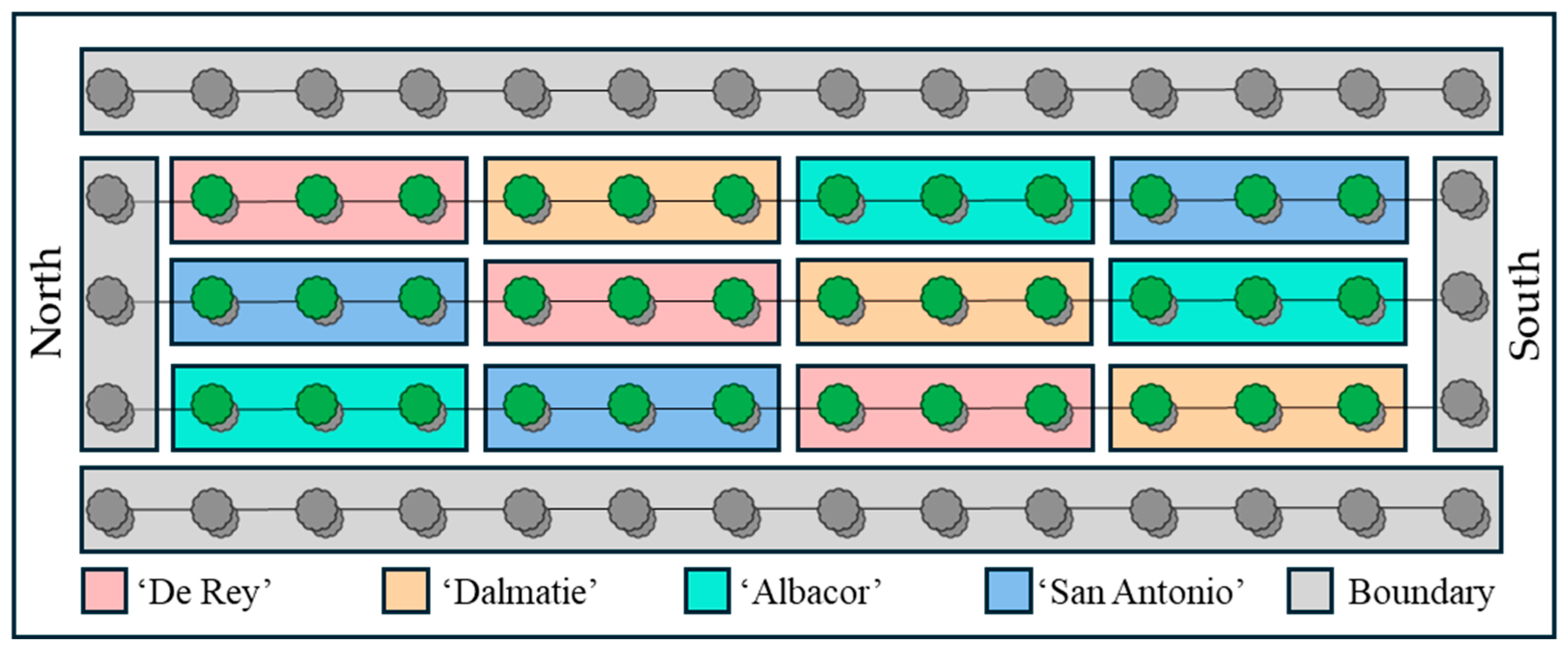
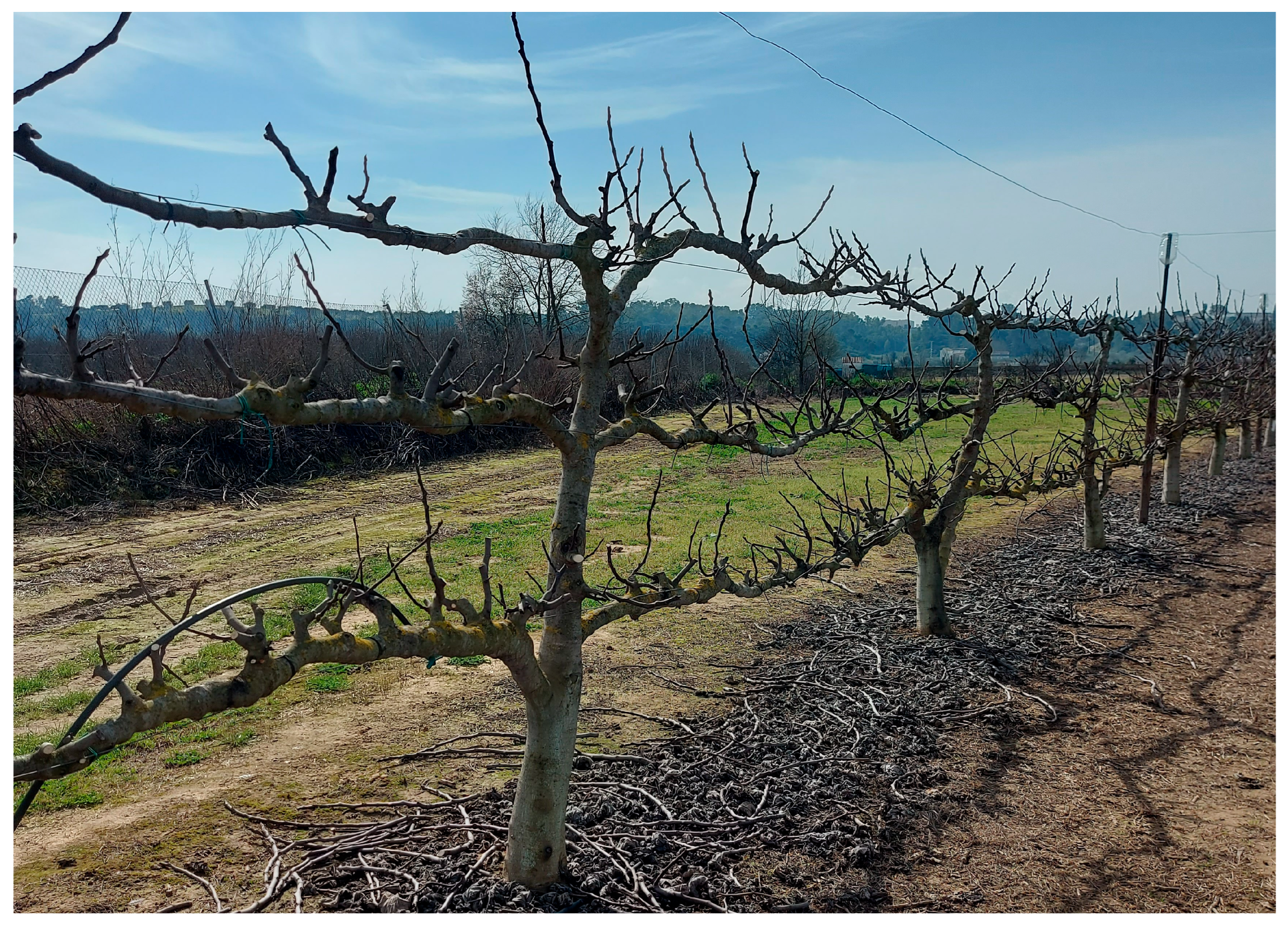


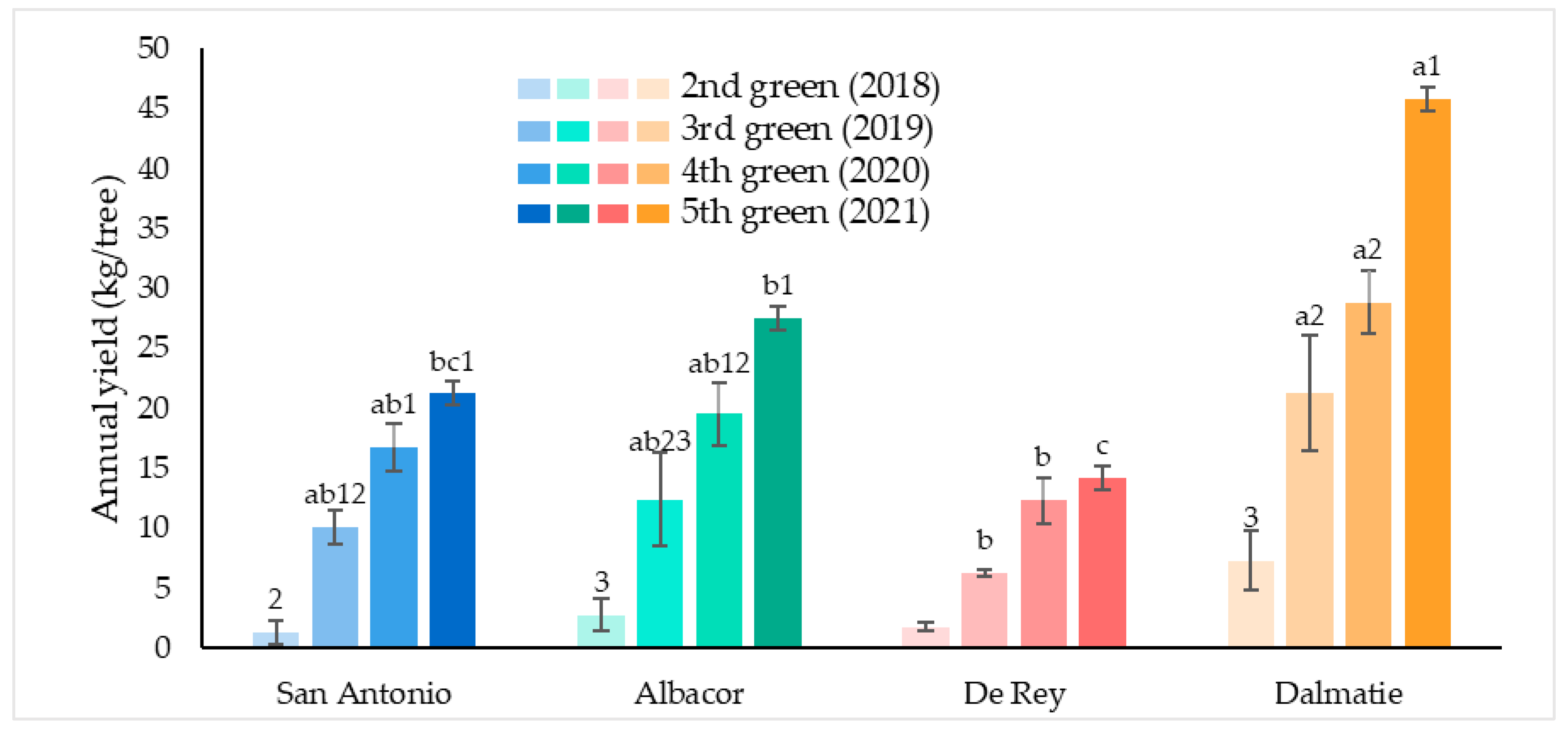
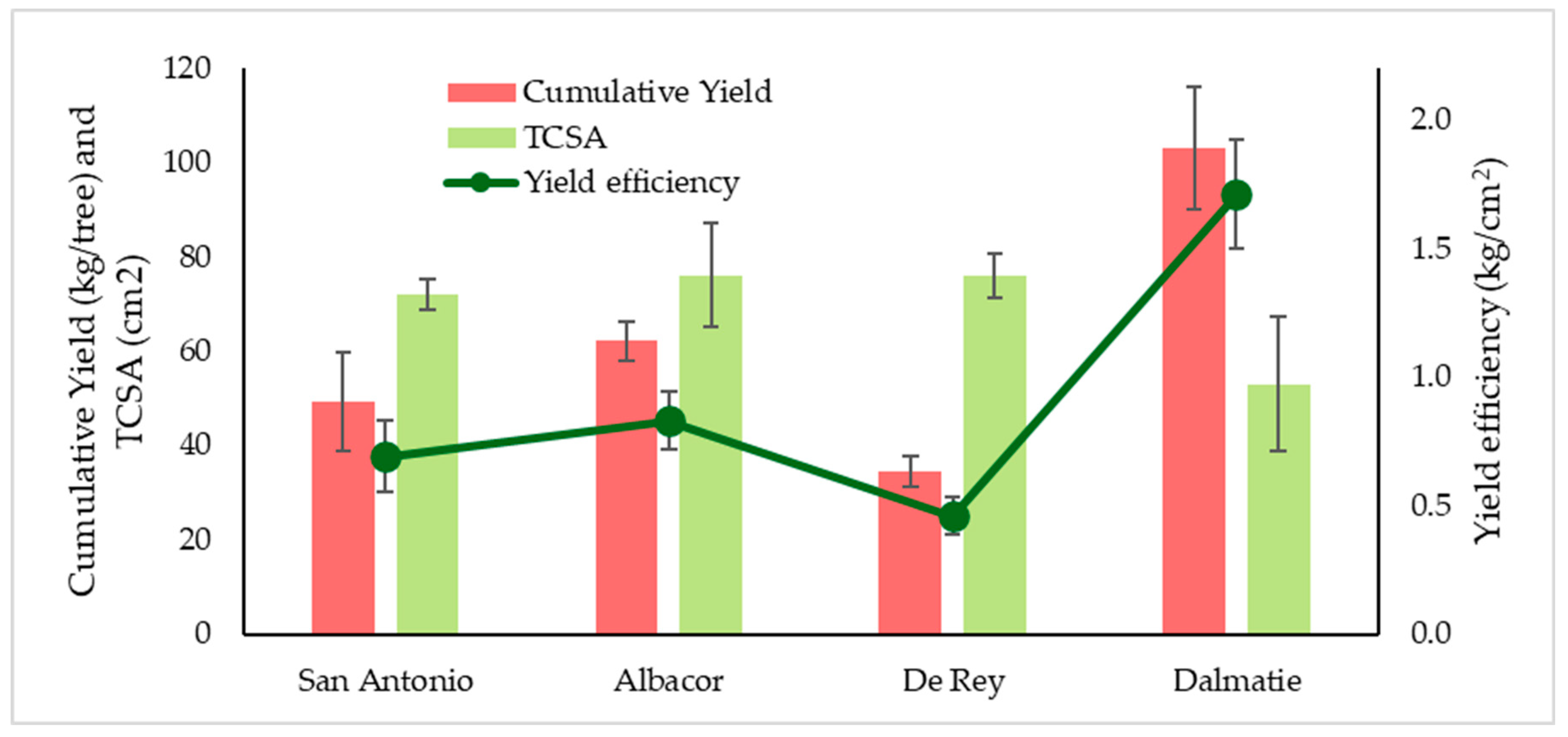
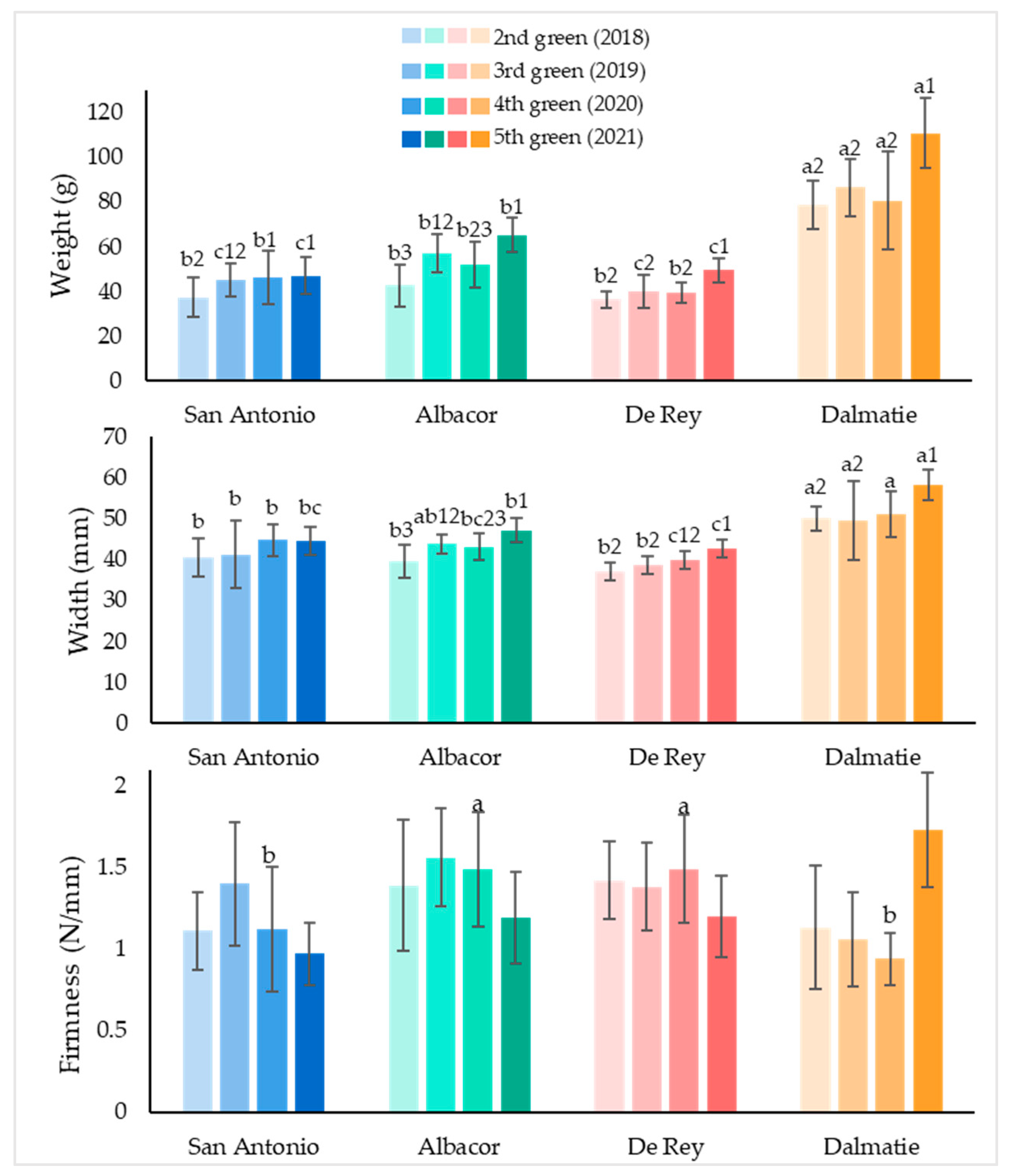

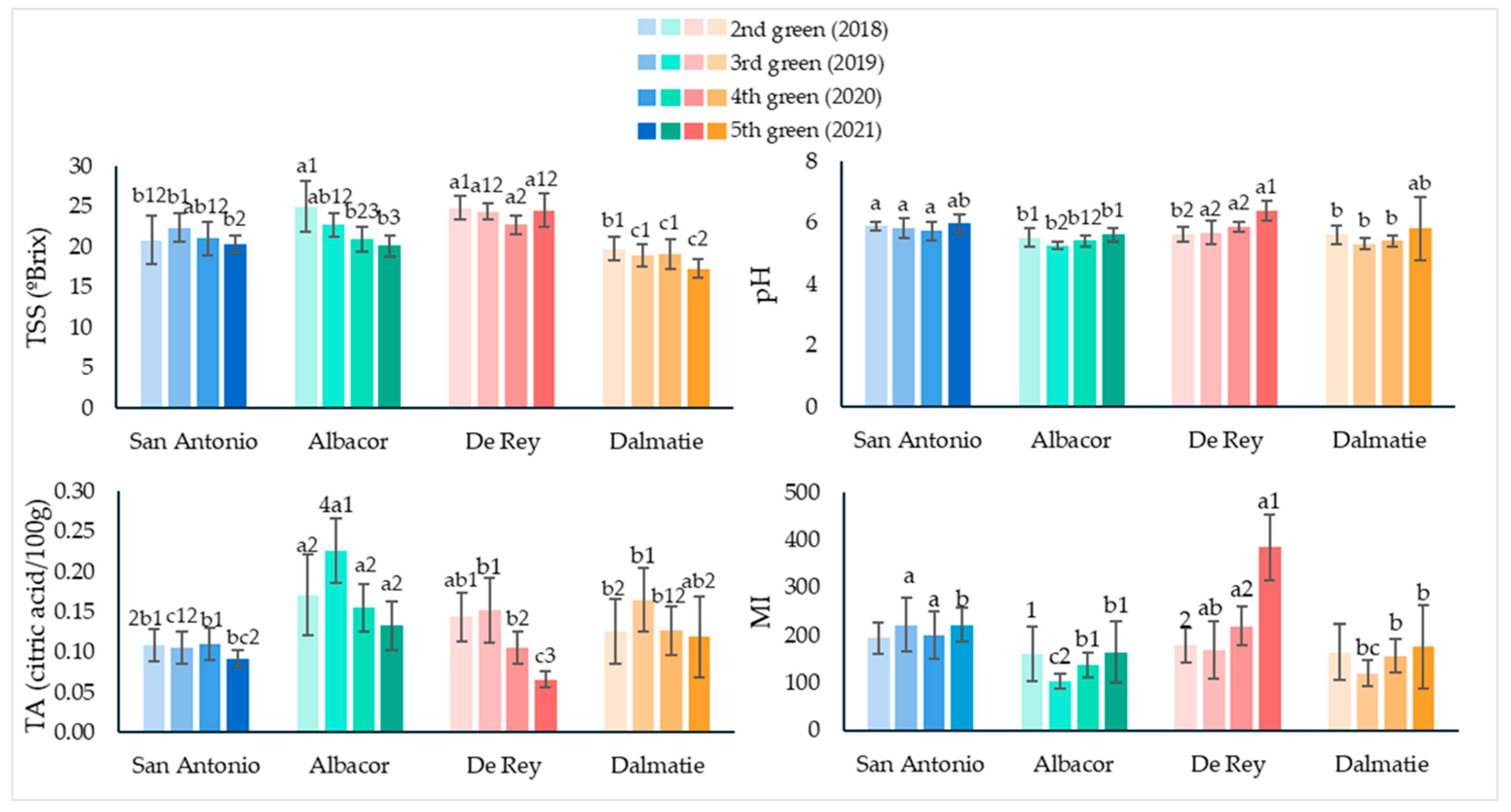
| Dependent Variable | Source of Variation | df | F | p | Partial η2 |
|---|---|---|---|---|---|
| Annual yield | Year | 3 | 65.9 | <0.001 | 0.86 |
| Variety | 3 | 34.7 | <0.001 | 0.76 | |
| Year × Variety | 9 | 3.3 | 0.006 | 0.48 | |
| Weight | Year | 3 | 63.0 | <0.001 | 0.17 |
| Variety | 3 | 481.7 | <0.001 | 0.60 | |
| Year × Variety | 9 | 4.5 | <0.001 | 0.04 | |
| Width | Year | 3 | 96.3 | <0.001 | 0.23 |
| Variety | 3 | 294.1 | <0.001 | 0.48 | |
| Year × Variety | 9 | 4.3 | <0.001 | 0.04 | |
| Firmness | Year | 3 | 0.5 | 0.697 | 0.01 |
| Variety | 3 | 2.8 | 0.043 | 0.04 | |
| Year × Variety | 9 | 2.6 | 0.007 | 0.10 | |
| TSS | Year | 3 | 14.2 | <0.001 | 0.17 |
| Variety | 3 | 76.0 | <0.001 | 0.52 | |
| Year × Variety | 9 | 5.7 | <0.001 | 0.20 | |
| pH | Year | 3 | 12.2 | <0.001 | 0.15 |
| Variety | 3 | 18.6 | <0.001 | 0.21 | |
| Year × Variety | 9 | 2.1 | 0.034 | 0.08 | |
| TA | Year | 3 | 27.8 | <0.001 | 0.29 |
| Variety | 3 | 39.0 | <0.001 | 0.36 | |
| Year × Variety | 9 | 4.3 | <0.001 | 0.16 | |
| MI | Year | 3 | 22.3 | <0.001 | 0.25 |
| Variety | 3 | 37.1 | <0.001 | 0.36 | |
| Year × Variety | 9 | 9.1 | <0.001 | 0.29 |
Disclaimer/Publisher’s Note: The statements, opinions and data contained in all publications are solely those of the individual author(s) and contributor(s) and not of MDPI and/or the editor(s). MDPI and/or the editor(s) disclaim responsibility for any injury to people or property resulting from any ideas, methods, instructions or products referred to in the content. |
© 2025 by the authors. Licensee MDPI, Basel, Switzerland. This article is an open access article distributed under the terms and conditions of the Creative Commons Attribution (CC BY) license (https://creativecommons.org/licenses/by/4.0/).
Share and Cite
Galán, A.J.; Domínguez, M.G.; Pérez-López, M.; Galván, A.I.; Pérez-Gragera, F.; López-Corrales, M. Agronomic Performance and Fruit Quality of Fresh Fig Varieties Trained in Espaliers Under a High Planting Density. Horticulturae 2025, 11, 750. https://doi.org/10.3390/horticulturae11070750
Galán AJ, Domínguez MG, Pérez-López M, Galván AI, Pérez-Gragera F, López-Corrales M. Agronomic Performance and Fruit Quality of Fresh Fig Varieties Trained in Espaliers Under a High Planting Density. Horticulturae. 2025; 11(7):750. https://doi.org/10.3390/horticulturae11070750
Chicago/Turabian StyleGalán, Antonio Jesús, María Guadalupe Domínguez, Manuel Pérez-López, Ana Isabel Galván, Fernando Pérez-Gragera, and Margarita López-Corrales. 2025. "Agronomic Performance and Fruit Quality of Fresh Fig Varieties Trained in Espaliers Under a High Planting Density" Horticulturae 11, no. 7: 750. https://doi.org/10.3390/horticulturae11070750
APA StyleGalán, A. J., Domínguez, M. G., Pérez-López, M., Galván, A. I., Pérez-Gragera, F., & López-Corrales, M. (2025). Agronomic Performance and Fruit Quality of Fresh Fig Varieties Trained in Espaliers Under a High Planting Density. Horticulturae, 11(7), 750. https://doi.org/10.3390/horticulturae11070750








